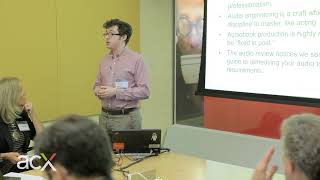How to Succeed at Audiobook Production: Part 1
Posted on June 26, 2014 by Scott Jacobi
Welcome to another installation of Andrew the Audio Scientist's insights on audiobook production! Today, I present the first part in my four-week video series, How to Succeed at Audiobook Production. Week 1 addresses the preparation and recording of a new ACX title. Coming up, we'll cover editing, mastering, and delivering your audiobook productions.
Achieving Consistency in Audiobook Production
Ask any member of the ACX Quality Assurance team what the most important aspect of audiobook production is, and they'll all give the same answer: consistency. Your time on ACX should be spent acquiring new acting gigs, not tinkering with the technical details of last-minute production issues. To help you achieve consistency and avoid pesky technical problems that could threaten the success of your productions, I'd like to share with you my presentation from the 2014 Narrator Knowledge Exchange, which details a new concept I've dubbed "The ACX Mile."
The ACX Mile
To better understand the need for methodological production, I have broken down audiobook production into a comprehensible four-step procedure, which I lovingly refer to as The ACX Mile. When running a race on a track, a runner may not begin a new lap until he or she has fully completed the current lap. Consider the audiobook production process as a four-lap race, with an appropriate warm-up period preceding it:
Warm Up: Script and Studio Preparation
Lap One: Recording
Lap Two: Editing and QC
Lap Three: Mastering
Lap Four: Encoding and Delivery
Now, watch part one of How to Succeed at Audiobook Production, and after, review the pre-production and recording tips I address in the video.

Basic Recording Tips for Successful Audiobook Production
Draft a production schedule
– An experienced ACX producer will spend roughly six hours in production for every hour of completed audio. This means that for a five hour title, an ACX producer should anticipate spending at least 30 hours on the successful production and completion of their title.
Perform a thorough script prep
– Before recording, ensure you've read, notated, and fully understood every line of your title. Audiobooks are all about using your voice to tell your Rights Holder's story, so fidelity to the title is a necessity. Send questions unanswered by your script prep to your Rights Holder, and don't be afraid to do some research. Sites like AudioEloquence.com
are great for determining the accepted pronunciations of foreign, historical, and other uncommon words.
Log your optimal settings
– Once you've obtained a good microphone gain on your audio interface and positioned your microphone perfectly, mark the area with electrical tape so you have a reference. This way, on the following day of recording, you'll be able to set your position and settings to the exact same positions as before.
Verify your room tone before recording
– After setting your record levels, ensure you have recorded 30 seconds of clean room tone to analyze. Listen back to your recording with headphones, ensuring no undesirable sounds are contained within. If the sound is clean and quiet, you should be ready to record.
Back up your raw audio
– If you have not established a file backup technique, see my previous post on
Noise reduction plugins can't fix a bad recording
– Utilizing plugins, such as noise and click reduction, is strongly discouraged. The improper use of such software may introduce new artifacts and undesirable sounds into your audiobook, and they are rarely effective at addressing the noise concerns of audiobooks.
If the room in which you're recording is just too noisy, even after isolating your space, putting up acoustic panels to deaden reflections, and utilizing an in-line high-pass filter to reduce rumble and hum, it's likely your recording space is not located in an ideal setting. The best solution may be to simply install your recording studio elsewhere. Such a step may seem drastic, but nothing is more important to a successful audiobook production than a great initial record.
It is important to keep in mind that, like a marathon, The ACX Mile is best run slow-and-steady. Very few audio errors can truly be “fixed in post,” so it is best to start off on the right foot, even if that makes the actual work a little more time-consuming. I suggest making an ideal and permanent recording setup a top priority. Luckily for you, great audiobooks consist of only two components: your narration, and the recording space. Get that step of the production process down pat, and the rest will come with a little perseverance and healthy amount of impassioned storytelling.
Read part 2, which covers audiobook editing and QC, here.